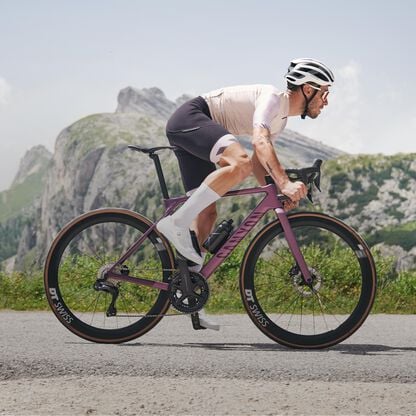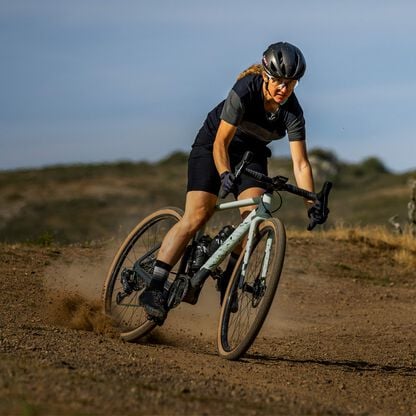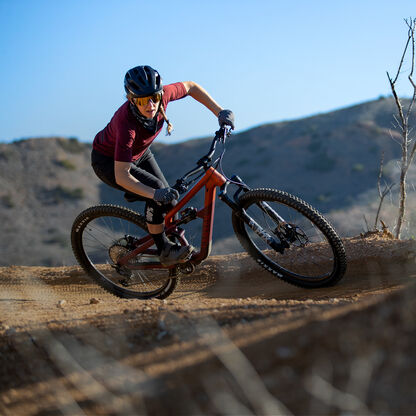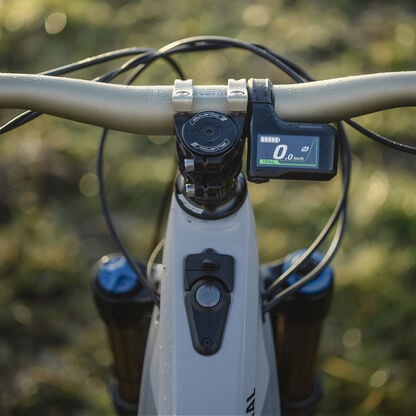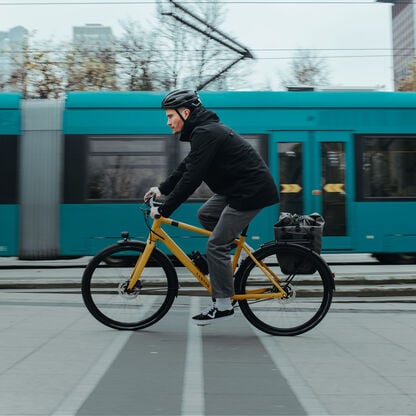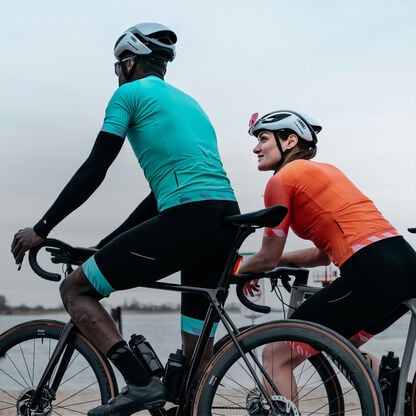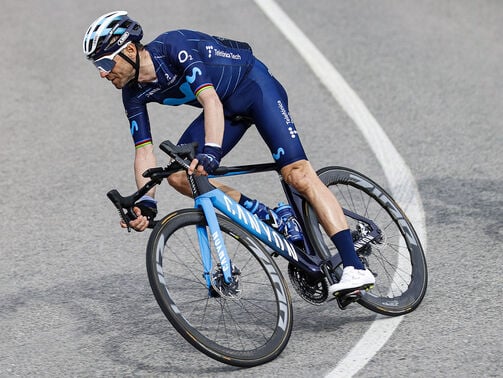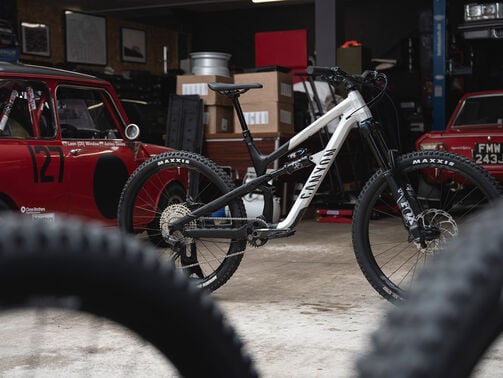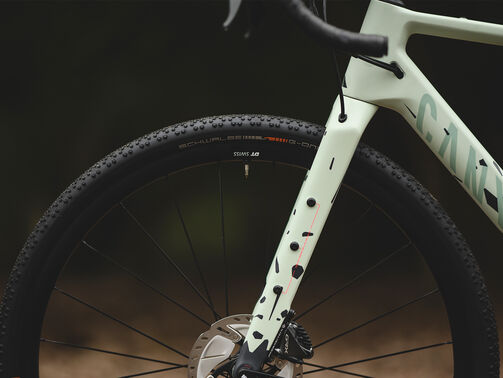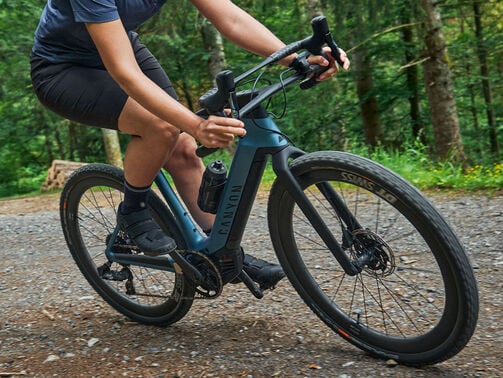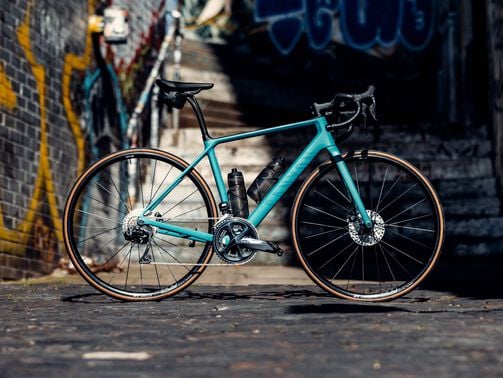Bike tyre pressure: Complete guide to correct pressure, pumps, and tips
Achieving optimum bike tyre pressure may be the single biggest improvement that you can make to your riding experience. But what is the optimal psi for bike tyres?


Tyre pressure affects how well your bike handles and your comfort as a rider. It’s one of the most impactful factors in how your bike feels to ride – and luckily it’s also one of the easiest to fix or fine-tune yourself.
Contents
What is bike tyre pressure and why is it important?
When we talk about pressure in relation to bicycle tyres, what we’re really talking about is how much air there is inside. This in turn affects how hard or soft your tyres feel. Pressure is measured in two different units – bar and pounds per square inch (psi). Psi is more commonly used in North America, while bar is more common in the rest of the world.
We’ve already established that tyre pressure has a big impact on both ride feel and comfort. On top of that, the correct bike tyre pressure saves damage to your wheels, tyres, tubes and yourself! The right tyre pressure also has the potential to extend your e-bike battery life. A perfectly pumped up tyre is less of a drain on the battery power meaning you keep your wheels turning for longer.
While under-inflation is the most common problem, over-inflation can be just as bad. There is a sweet spot and hitting it can seriously improve your ride.
Factors that influence bike tyre pressure
Tyre type and size, riding conditions, as well as bike and rider weight are all factors that affect the recommended psi for bike tyres.
Mountain bike tyres are fatter than those of road bikes and the wider rims allow you to run lower pressures. They are also intended to be used on rough and loose surfaces, so the greater traction and shock absorption given by slightly softer tyres become more important.
Road bikes' narrower wheel rims need a higher tyre pressure to maintain rigidity. Thankfully though, road bike tyre pressures are no longer expected to be as high as the 160psi once recommended. 100 or 90psi may be fine with 28mm tyres.
Tubeless tyres have risen in popularity over the last few years particularly on road bikes because of their ability to run lower pressures without risking pinch flats (Learn more about when to change your road bike tyres and how to do it in our complete guide). Tubeless tyres are also more puncture resistant saving you time and money in the long run.
For both road and mountain bikes, you may want to adjust your tyre pressures down a little if you are anticipating rough conditions. For example, cobbles or a poor-quality surface for road bikes, or very rough or steep trails for mountain bikes, will be better handled by softer tyres.
Normal bike tyre pressure recommendations are based on a rider's weight of 70kg and a bike of 12kg. Tyre pressure for heavy riders will need to be rather higher. You should adjust your optimum pressures by about 1% per 10kg up or down from these base figures. Electric bike tyre pressure can be calculated in the same way: the battery usually adds about 10kg.
Why should I try lower tyre pressure?
Softer tyres act as suspension on rough roads or off-road trails. They also maintain more contact with the road at any given moment, meaning improved grip and confidence when cornering. Braking, cornering and uphill traction are better on mountain bikes with softer tyres.
However, there are problems when the air pressure in tyres is too low. The greater ground contact may mean better grip, but it also results in greater rolling resistance. This leads to greater tyre wear. Under-inflated tyres are also more prone to pinch flats. The soft tyre deforms when it hits rough ground or potholes, pinching the inner tube against the rim.
What about hard tyres?
Higher pressures have long been the norm for road bikes. Hard tyres, in principle at least, offer less rolling resistance. In practice, however, road surfaces are rarely all that smooth and tyres inflated to the max are likely to be quite unforgiving. Furthermore, on rougher road surfaces and off-road, the additional vibration and jolts are not only uncomfortable, but they will also actually slow you down as much as under-inflated tyres.
There are also risks of damage with too much inflation pressure. Tyres do burst when significantly over-inflated, either during pumping or, more dangerously, when riding. You can also damage the valve or the pump. It is important, then, to discover what the optimum tyre pressure for a bicycle is.

Recommended tyre pressures for different bike types
Each style of bicycle has different tyre pressure requirements. Manufacturers usually have a maximum pressure embossed on the wall of the tyre. Inflating tyres over these maximum pressures is not advised. The optimum pressure, though, is likely to be less than the max shown.
First we’ll look at the most common types of bicycle, then at the bottom of this section you’ll find a table covering the full range.
Road bike tyre pressures
Road bikes require the highest tyre pressure of any bike style. This is because they’re designed for speed on smooth surfaces, where the likelihood of your tyres needing to absorb a large bump are much rarer than, for instance, mountain biking. If you do hit a pothole or similar while riding your road bike, having high tyre pressure will reduce the risk of a pinch flat occurring.
You can find out everything you ever wanted to know about road bike tyre pressure in our in-depth guide.
Gravel bike tyre pressures
The right tyre pressure for gravel bikes sits somewhere between mountain bike and road, which makes complete sense when you consider the demands of gravel cycling. You want to maintain good speed on the flatter, smoother sections of gravel, but don’t want to come unstuck when tackling slightly more challenging surfaces.
We created a deep dive into the right gravel bike tyre pressure, which covers the subject in greater detail.
MTB tyre pressures
Mountain bike tyres are much wider than road tyres, and they require far less air pressure to run safely and efficiently. Generally, the lowest pressures are found in enduro and downhill bikes, which tackle big drops and jumps – often at speed. Cross-country bikes typically have higher tyre pressure, to make them more efficient when pedalling longer distances and uphill.
Learn all about the best MTB tyre pressure in our comprehensive guide.
E-bike tyre pressures
E-bike tyre pressure is the hardest to define because of the incredible range of different activities you can do on an electric bicycle. There are e-road and e-MTB bikes, electric-assist bikes for the city and ones geared toward specific sporting disciplines (like e-enduro in the UCI MTB World Series).
We have looked at some of these considerations in a dedicated article, so you can figure out the right e-bike tyre pressure for you.
Perfect tyre pressure - information table
Ever asked yourself what should bike tyre pressure be? Our table below has the answer.
| Bike type | Tyre width | Pressure (bar) | Pressure (psi) |
|---|---|---|---|
| Road bike | 23 -28mm | 6 - 8bar | 90 - 120psi |
| Mountain bike (hardtail/cross-country) | 54 - 61mm | 1.8 - 2.5bar | 26 - 36psi |
| Mountain bike (enduro/downhill) | 58 – 64mm | 1.6 - 2.2bar | 23 - 32psi |
| Gravel bike | 30 - 52mm | 2.5 – 4.5bar | 36 - 58psi |
| Touring bike | 35 - 50mm | 3 - 5bar | 44 - 72psi |
| E-bike | 38 - 50mm | 3 - 4bar | 44 - 58psi |
| Fat bike | 96 – 127mm | 0.5 - 1.5bar | 7 - 22psi |
| City bike | 32 - 47mm | 3 - 4.5bar | 44 - 65psi |

How to measure and adjust my bike tyre pressure
The simplest way of seeing your bike tyre pressure is to use a pump with a pressure gauge built in. These are most common on upright-style ‘track pumps’. The gauges on these pumps aren’t always 100% accurate, but they do a good job of helping you get the pressure in about the right place.
The most accurate reading, however, will come from a bike tyre pressure gauge. If you are serious about refining your tyre pressures, it’s worth investing in a quality digital gauge. To use it, you just place the nozzle over the valve to get a reading.
If you have no pressure gauge, some manual tests can help, though they are far from accurate. The tyre should yield only very slightly when firmly pressed. Also, try pressing down with all of your weight on the saddle: there should be little or no deformation of the tyres.
When it comes to adjusting your bike tyre pressure, it’s simply a case of using the gauge you have available and adding or removing air until you hit the desired pressure level.
Common tyre pressure mistakes to avoid
One common mistake is over-inflating tyres by pumping them to the maximum psi listed on the sidewall without considering factors such as rider weight, bike type, or terrain. Overinflated tyres can lead to a harsh and uncomfortable ride, reduced grip, and an increased risk of punctures or blowouts, particularly on rough or uneven surfaces.
Under-inflating tyres is another frequent error. Riding with tyres that feel soft without using a pressure gauge can result in higher rolling resistance, poor handling, and a greater likelihood of pinch punctures or rim damage.
Additionally, many riders neglect to check tyre pressure regularly, assuming it's fine without realising how quickly it can drop, especially in tubeless or high-volume tyres. This can lead to poor performance and safety issues.
How to choose the right bike pump for your tyre pressure
A quality track pump offers the ability to hone your bicycle tyre psi. They generally have gauges, which may not be quite as accurate as a digital gauge, but are usually consistent. A floor pump will have switchable adapters to fit both Presta and Schrader valve types.
It is also wise to carry a hand pump with you when you're out. It is difficult to pump tyres to full inflation with a hand pump, but they are absolutely essential in case of a puncture (along with spares or a repair kit).
Expert tips for optimising bicycle tyre pressure
Many pumps these days have a clamping attachment to fit over the head of both Presta and Schrader valves. However, the attachment will need to be swapped or reversed to fit. Some high-quality floor pumps use a screw-on fixing for a more reliable seal. In any case, it is important to ensure a good fit over the valve. When pumping, you should not hear air hissing from the valve.
With Presta valves, it is necessary to loosen the head nut at the end to allow air to enter the valve. You may also need to press it down slightly to release a little air, as the entry point can become stuck.
It's worth experimenting a little, as personal factors do vary. However, with the right tyre pressure, you can ensure the most comfortable, efficient and safest ride and the best cycling experience.

What’s the best tyre pressure for my ride?
The best bicycle tyre psi for your ride depends on a variety of factors and should be adjusted to suit your individual needs. Recommended pressure ranges are often printed on the sidewall of your tyres and provide a useful starting point. Tyre type and size are key considerations; narrower road tyres typically require higher pressures (e.g., 80–120psi), while wider mountain bike or gravel tyres work better at lower pressures (e.g., 20–50psi) to maximise traction and grip. Weather and temperature also play a role, as cold weather can reduce pressure slightly, and wet or muddy conditions often call for lower pressures to improve grip.
Additionally, your load - such as rider weight, luggage, or panniers - affects the ideal pressure; heavier loads may need higher pressures to prevent squashing the tyre excessively. Personal preference is also important, with some riders favouring softer tyres for comfort and control, while others prioritise firmer pressures for speed and efficiency. Ultimately, the best pressure is a balance that suits your terrain, riding style, and comfort, so don’t hesitate to experiment and fine-tune your setup.
Did this article help?
Thank you for your feedback
